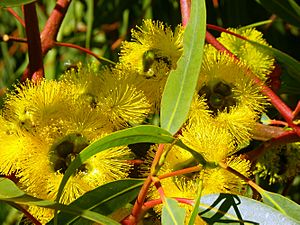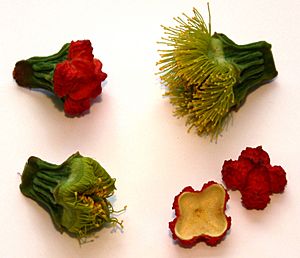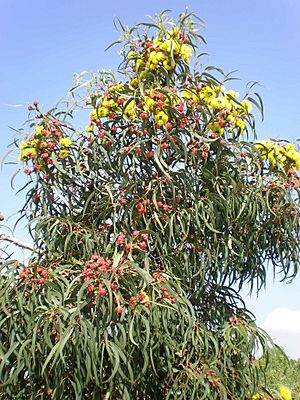Illyarrie facts for kids
Quick facts for kids Illyarrie |
|
|---|---|
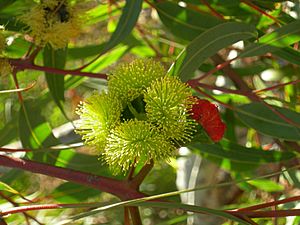 |
|
| Scientific classification | |
| Genus: |
Eucalyptus
|
| Species: |
erythrocorys
|
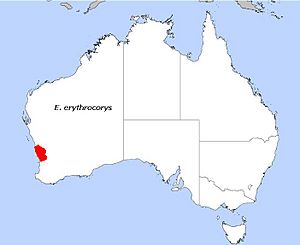 |
|
| E. erythrocorys, field distribution | |
The Illyarrie (pronounced ill-YAR-ree), also known as the red-capped gum or helmet nut gum, is a special tree from Western Australia. It can grow as a single tree or as a "mallee," which means it has many stems growing from the ground. This tree is famous for its smooth bark, unique leaves, and big, bright red flower buds. It also has bright yellow flowers and interesting bell-shaped fruits.
Contents
What the Illyarrie Looks Like
The Illyarrie is usually a small tree or a mallee. It often grows to be about 3–10 m (9.8–32.8 ft) tall and 3–6 m (9.8–19.7 ft) wide. It has an open, spreading shape.
Bark and Leaves
The bark of the Illyarrie is smooth and creamy white. Sometimes, you might see a few rough brown patches on the trunk. The smooth bark peels off in small strips or flakes.
Young Illyarrie plants have hairy stems. Their leaves are shaped like a spear or a heart. These young leaves are about 50–130 mm (2.0–5.1 in) long and 30–60 mm (1.2–2.4 in) wide.
Adult leaves grow in pairs. They are thick and glossy green on both sides. These leaves are often curved or shaped like a sickle. They can be 90–200 mm (3.5–7.9 in) long and 12–30 mm (0.47–1.18 in) wide. They grow on a flat stalk called a petiole, which is about 15–30 mm (0.59–1.18 in) long.
Flowers and Fruit
The flower buds grow in groups of three. They are attached to a stalk about 12–26 mm (0.47–1.02 in) long. Each bud sits on a smaller stalk about 2–10 mm (0.079–0.394 in) long.
Mature buds are oval-shaped and quite large. They are about 20–25 mm (0.79–0.98 in) long and 20–26 mm (0.79–1.02 in) wide. A bright red, flattened cap covers the flower. This cap is called an operculum. It has four parts.
The flowers themselves are bright yellow or greenish-yellow. They usually bloom between February and April. The flowers have stamens (the parts that make pollen) arranged in four groups.
After the flowers, the tree produces woody fruits. These fruits are shaped like a wide bell. They are about 28–40 mm (1.1–1.6 in) long and 30–55 mm (1.2–2.2 in) wide. Sometimes, there are so many fruits that they make the tree branches droop down.
How Illyarrie Got Its Name
The scientific name for this tree is Eucalyptus erythrocorys. It was first officially described in 1860 by a scientist named Ferdinand von Mueller.
Meaning of the Name
The name erythrocorys comes from two Greek words. "Erythro" means "red," and "corys" means "helmet." This name refers to the bright red, helmet-like cap on the flower buds.
The common name, Illyarrie, is what the Noongar people call this plant. The Noongar are an Aboriginal Australian people from Western Australia.
Where Illyarrie Grows
The Illyarrie grows in a specific area north of Perth in Western Australia. You can find it on rocky limestone hills and outcrops. It grows in sandy, alkaline soils near Dongara. It also grows north of Kalbarri National Park.
You can also find it on sandy plains. These plains are located between Shark Bay and Jurien.
Illyarrie's Conservation Status
The Western Australian Government's Department of Parks and Wildlife says that the Illyarrie is "not threatened." This means it is not currently in danger of disappearing.
Growing Illyarrie Trees
The Illyarrie is a popular tree to grow in gardens across Australia. You can buy its seeds or young plants. The seeds sprout easily.
Care and Uses
This tree can sometimes look a bit messy, but you can easily keep it neat with a light trim. Its colorful flowers attract birds that like nectar.
Illyarrie trees are known to drop branches sometimes. This happens because the heavy fruits can weigh down the limbs. The tree grows fairly quickly. It can handle drought (dry periods) and smog (air pollution). However, it can be sensitive to frost.
It grows best in full sun and in soil that drains well. You can even grow it in large pots or near the coast. The beautiful flowers are sometimes used to make wreaths.


